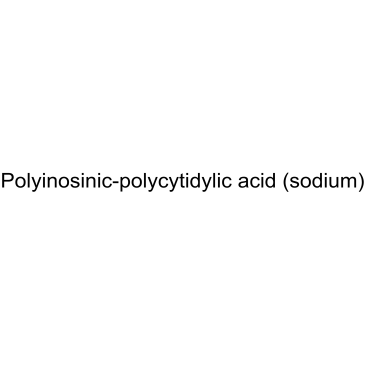Polyinosinic-polycytidylic acid sodium

Polyinosinic-polycytidylic acid sodium structure
|
Common Name | Polyinosinic-polycytidylic acid sodium | ||
|---|---|---|---|---|
| CAS Number | 42424-50-0 | Molecular Weight | 694.4 | |
| Density | N/A | Boiling Point | N/A | |
| Molecular Formula | C19H27N7NaO16P2 | Melting Point | N/A | |
| MSDS | USA | Flash Point | N/A | |
Use of Polyinosinic-polycytidylic acid sodiumPolyinosinic-polycytidylic acid sodium (Poly(I:C) sodium) is a synthetic analog of double-stranded RNA and an agonist of toll-like receptor 3 (TLR3) and retinoic acid inducible gene I (RIG-I)-like receptors (RIG-I and MDA5). Polyinosinic-polycytidylic acid sodium can be used as a vaccine adjuvant to enhance innate and adaptive immune responses, and to alter the tumor microenvironment. Polyinosinic-polycytidylic acid sodium can directly trigger cancer cells to undergo apoptosis[1][2]. |
| Name | polyinosinic-polycytidylic acid sodium salt |
|---|---|
| Synonym | More Synonyms |
| Description | Polyinosinic-polycytidylic acid sodium (Poly(I:C) sodium) is a synthetic analog of double-stranded RNA and an agonist of toll-like receptor 3 (TLR3) and retinoic acid inducible gene I (RIG-I)-like receptors (RIG-I and MDA5). Polyinosinic-polycytidylic acid sodium can be used as a vaccine adjuvant to enhance innate and adaptive immune responses, and to alter the tumor microenvironment. Polyinosinic-polycytidylic acid sodium can directly trigger cancer cells to undergo apoptosis[1][2]. |
|---|---|
| Related Catalog | |
| Target |
TLR3[2], RIG-I[2], MDA5[2], apoptosis[2] |
| In Vitro | Polyinosinic-polycytidylic acid (20 ng/mL; 24 hours; WM793, WM278, WM239A, WM9 and 1205Lu cells) treatment strongly reduces viability from 100% in controls to 20%–50% within 24 hours[1]. Polyinosinic-polycytidylic acid (200 ng/mL; 24 hours; 1205Lu cells) treatment induces apoptosis in 1205Lu cells[1]. Polyinosinic-polycytidylic acid (3 ng/mL; 24 hours; 1205Lu cells) treatment induces IFN-β expression in melanoma cells. Silencing of RIG-I and MDA-5 confirmed that induction of IFN-β by Polyinosinic-polycytidylic acid required RIG-I and MDA-5, respectively, and that required IPS-1[1]. Polyinosinic-polycytidylic acid (5 ng/mL; 24 hours; 1205Lu cells) treatment reveals active subunits of caspase-9 and caspase-8 in melanoma cells[1]. Cell Viability Assay[1] Cell Line: WM793, WM278, WM239A, WM9 and 1205Lu cells Concentration: 20 ng/mL Incubation Time: 24 hours Result: Strongly reduced viability from 100% in controls to 20%–50% within 24 hours. Apoptosis Analysis[1] Cell Line: 1205Lu cells Concentration: 200 ng/mL Incubation Time: 24 hours Result: Induced apoptosis in 1205Lu cells. RT-PCR[1] Cell Line: 1205Lu cells Concentration: 3 ng/mL Incubation Time: 24 hours Result: Induced IFN-β expression in melanoma cells. Western Blot Analysis[1] Cell Line: 1205Lu cells Concentration: 5 ng/mL Incubation Time: 24 hours Result: Revealed active subunits of caspase-9 and caspase-8 in melanoma cells. |
| In Vivo | Polyinosinic-polycytidylic acid treatment inhibits tumor growth in NOD/SCID immunodeficient mice injected with 1205Lu cells. The level of human DNA is 50% lower in mice treated with Polyinosinic-polycytidylic acid[1]. |
| References |
| Molecular Formula | C19H27N7NaO16P2 |
|---|---|
| Molecular Weight | 694.4 |
| InChIKey | GETQKWBYQAUFQM-VRQAYDGLSA-N |
| SMILES | Nc1ccn(C2OC(COP(=O)(O)O)C(O)C2O)c(=O)n1.O=c1[nH]cnc2c1ncn2C1OC(COP(=O)(O)O)C(O)C1O.[Na] |
| Storage condition | −20°C |
| Water Solubility | H2O: soluble10mg/mL |
|
YK-4-279 effectively antagonizes EWS-FLI1 induced leukemia in a transgenic mouse model.
Oncotarget 6 , 37678-94, (2015) Ewing sarcoma is an aggressive tumor of bone and soft tissue affecting predominantly children and young adults. Tumor-specific chromosomal translocations create EWS-FLI1 and similar aberrant ETS fusio... |
|
|
WFDC1 is a key modulator of inflammatory and wound repair responses.
Am. J. Pathol. 184(11) , 2951-64, (2014) WFDC1/ps20 is a whey acidic protein four-disulfide core member that exhibits diverse growth and immune-associated functions in vitro. In vivo functions are unknown, although WFDC1 is lower in reactive... |
|
|
The broad pattern recognition spectrum of the Toll-like receptor in mollusk Zhikong scallop Chlamys farreri.
Dev. Comp. Immunol. 52 , 192-201, (2015) Toll-like receptors (TLRs) are among the most studied pattern recognition receptors (PRRs) playing essential roles in innate immune defenses. In the present study, the basic features of CfTLR in mollu... |
| MFCD00131984 |